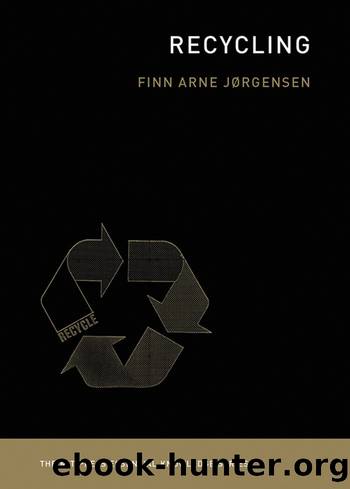Recycling by Finn Arne Jorgensen

Author:Finn Arne Jorgensen [Jørgensen, Finn Arne]
Language: eng
Format: epub
Tags: waste; discards; discard studies; technology; environment; Earth Day; Graphic design; Materials; Recycling junction; recycling symbol; Plastic; PET bottle; Ocean plastics; Curbside recycling; Organic waste; Composting; Food waste; Excrement; Waste stream; Paper; Papyrus; Parchment; Downcycling; Clothes; Textiles; Shoddy; Design; Fashion; Glass; Bottles; Disposables; Coca-Cola; Keep America Beautiful; Bottle bills; Class; litter; Infrastructures; Systems; Life Cycle Analysis; Aluminum; Resirk; e-waste; electronic waste; Obsolescence; Agbogbloshie; Health and safety; Labor; Industrial waste; Industrial ecology; Industrial metabolism; Waste regimes; Shipbreaking; Mines; Environmental justice; Wastemindedness; citizenship
Publisher: MIT Press
Published: 2019-11-12T00:00:00+00:00
Design can serve to make processes both upstream and downstream visible to consumers—but it can also obscure them.
7
Plastic Futures
Mr. McGuire: I want to say one word to you. Just one word.
Benjamin: Yes, sir.
Mr. McGuire: Are you listening?
Benjamin: Yes, I am.
Mr. McGuire: Plastics.
Benjamin: Exactly how do you mean?
Mr. McGuire: There’s a great future in plastics. Think about it. Will you think about it?
The Graduate, 1967
Plastic was once touted as the material of the future. It has been associated with newness. Yet, plastic rapidly lost its luster. Today, plastic is everywhere, but it is generally seen as a low-value material—fake, cheap, ersatz. The question of plastics recycling brings us into an even messier territory than glass, paper, and aluminum do. Plastic comes in many varieties, which generally require different recycling processes. Plastic also degrades with recycling, meaning that unlike aluminum, plastic at some point inevitably turns to waste, material without value.
Plastic didn’t even exist 150 years ago. While quasi-plastic materials such as celluloid and shellac were in use for consumer and industrial products earlier, Leo Baekeland’s 1907 invention, Bakelite, was the first fully synthetic plastic. Since then, we have had a proliferation of plastic materials. Most plastics are used for industrial purposes where consumers never have an option to recycle it. This matters for how we approach plastics waste. Environmental campaigns often target consumer plastic such as plastic straws and plastic bags, but most is used behind the scenes, in construction and in supply chains.
The challenge with plastics recycling is that technically, there is no such thing as plastic. There are instead many different plastics, each with different material qualities. Technically, plastics are synthetic or partially synthetic polymers, usually derived from petrochemicals, although some bioplastics are made with other organic materials. Each type of plastic requires different processing for recycling. Experts can tell different plastics apart by look and feel—for instance, Doron and Jeffrey describe how Indian waste sorters have developed the necessary know-how. Most people—assuming they even care—have to depend on the packaging labeling, a recycling arrow triangle with a number in the center (see box).1 This type of labeling matters. Offenhuber argues that this is a matter of information and transparency: with recycling, the devil is in the details, and getting to those details can be difficult.2
Download
This site does not store any files on its server. We only index and link to content provided by other sites. Please contact the content providers to delete copyright contents if any and email us, we'll remove relevant links or contents immediately.
The Secret History by Donna Tartt(16627)
The Social Justice Warrior Handbook by Lisa De Pasquale(11489)
Thirteen Reasons Why by Jay Asher(7788)
This Is How You Lose Her by Junot Diaz(5774)
Weapons of Math Destruction by Cathy O'Neil(5037)
Zero to One by Peter Thiel(4824)
The Myth of the Strong Leader by Archie Brown(4789)
Promise Me, Dad by Joe Biden(4449)
Beartown by Fredrik Backman(4419)
Stone's Rules by Roger Stone(4416)
How Democracies Die by Steven Levitsky & Daniel Ziblatt(4399)
The Fire Next Time by James Baldwin(4343)
100 Deadly Skills by Clint Emerson(4079)
A Higher Loyalty: Truth, Lies, and Leadership by James Comey(4033)
Rise and Kill First by Ronen Bergman(4012)
The David Icke Guide to the Global Conspiracy (and how to end it) by David Icke(3883)
The Farm by Tom Rob Smith(3872)
Secrecy World by Jake Bernstein(3783)
The Doomsday Machine by Daniel Ellsberg(3731)
